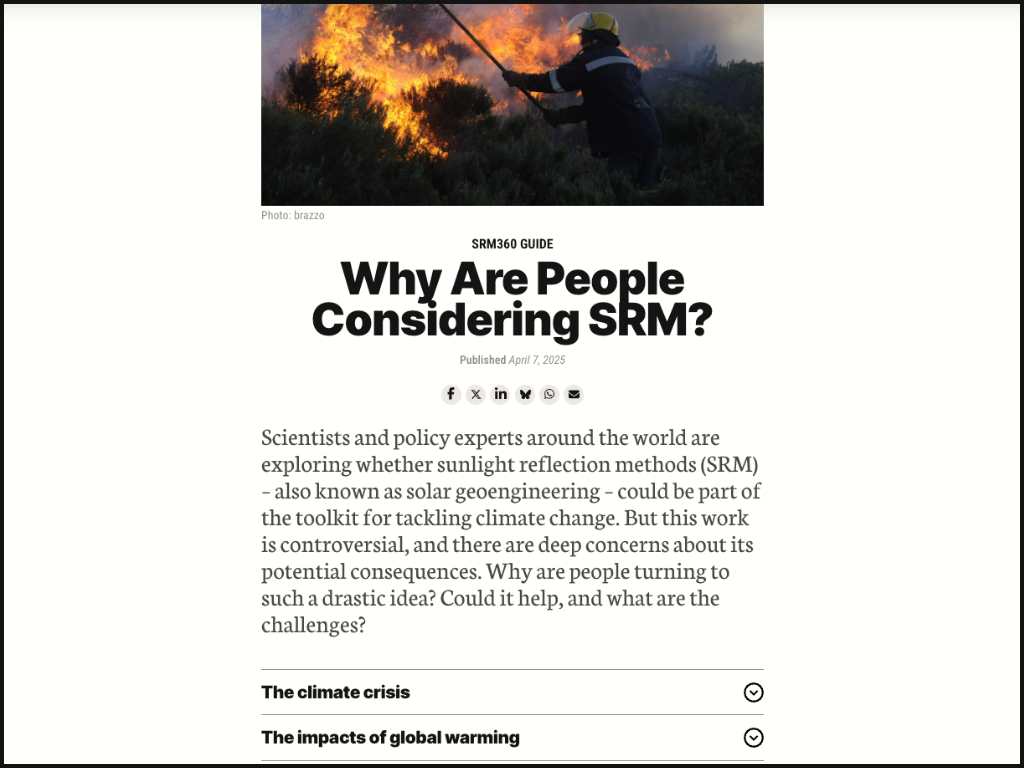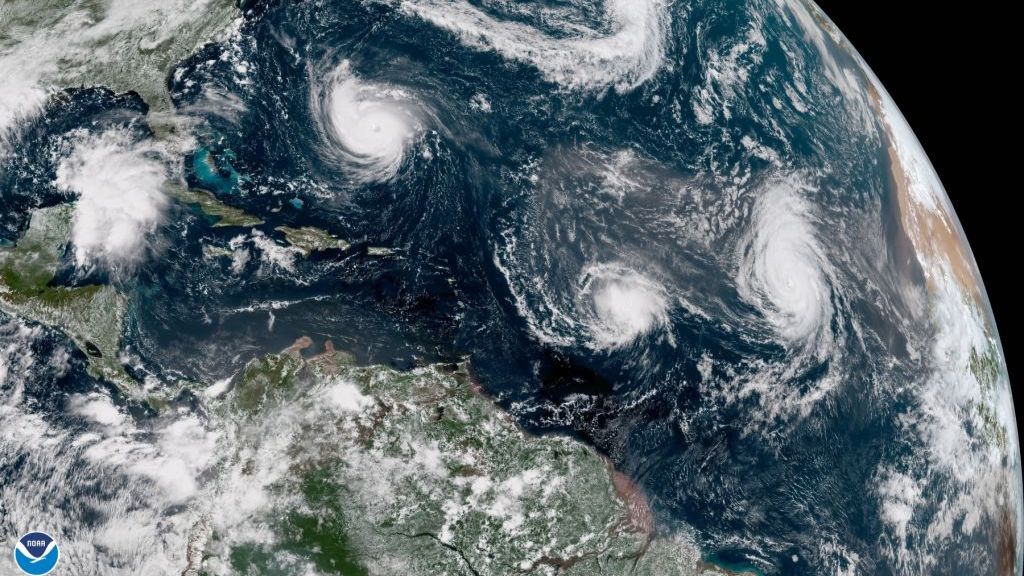|
|
April 2025 Update
Dear ,
SRM360.org underwent a bit of a facelift on Tuesday, but the changes are more than surface deep. We’ve revamped the site in response to audience feedback to make it more user-friendly and get you to the information you need more intuitively.
Over the next month, we’ll continue rolling out new features requested by the SRM360 community, including an events calendar and interactive tools to help map the solar geoengineering landscape.
Last week, we hosted the first of our new Making Sense live discussion series. Making Sense of calls for bans and moratoria for solar geoengineering explored the proliferation of calls for SRM bans at US state level, as well as international calls for a moratorium. We were delighted to see so many attendees and to hear the thoughtful questions posed by participants. Please feel free to suggest further topics for us to cover, and sign up to receive event updates.
There’s much to cover this month, so read on for the latest SRM academic highlights, community updates, and media coverage – including the US EPA's criticism of "cooling credits" start-up Make Sunsets.
-The SRM360 Team
|
|
|
Join Our SRM Researcher Database |
We are compiling a public database of SRM researchers. If you've written at least one academic paper on the topic and would like to join or find out more, please email experts@srm360.org.
|
| JOIN THE DATABASE
|
|
|
New From SRM360 |
|
|

|
|
|
Solar geoengineering is complex and multi-faceted. We’re excited to launch our SRM Guides, which give a high-level introduction to the key issues in a digestible, narrative form. Start with “Why Are People Considering SRM?” and continue the story from there.
|
|
|
|
|
|
|
|
|
Public and policymaker perceptions play a key role in resources dedicated to SRM research and potential development. In the April news roundup, Pete Irvine discusses academic research and policy developments with behavioural scientist Chad
Baum and legal analyst Julie Vinders.
Listen at srm360.org or on your preferred podcast platform.
|
|
|
|
|
|
|
SRM Academic Highlights |
 |
Getty Images. Credit: Richard Drury |
Is the messenger more important than the message?
Magistro et al. explored the importance of partisanship in public perceptions of SRM in the US and found that both Democrats and Republicans were more likely to align with the views of messengers from their own party, regardless of the framing of their message.
Approaching SRM with caution
Davies and Vinders argue that precautionary arguments cannot be made decisively for or against developing SRM. However, they suggest applying the precautionary principle would require comprehensive assessment of SRM before decision-making.
SAI could enhance cloud brightness
A new study by Gristey and Feingold shows that stratospheric aerosol injection (SAI) would enhance the brightness of clouds by scattering light to steeper angles. This effect is already present in climate models, but underappreciated.
Balancing risks
SRM is an inherently risky strategy, but do the risks outweigh climate change impacts? Felgenhauer et al. present a practical approach to risk-risk analysis to weigh the multiple and uncertain risks of SRM against those of climate change.
SRM could shorten global temperature overshoot
Boselius et al. explore the time commitment to SRM in overshoot scenarios and find that SRM is needed for up to about 20% less time than expected. This “overshoot shortening” effect that ends SRM deployment decades early was found to be due to avoided ocean warming.
Patents on SRM technology
Private investment in geoengineering research has increased in recent years, raising significant concerns. Ramos and Santos examine patent filings in the field of geoengineering, including SRM, and discuss their significance in the context of SRM governance.
|
|
|
Community and Events |
 |
Getty Images. Credit: Craig Barrit |
Isaac Asimov Memorial Debate on geoengineering
Neil deGrasse Tyson and leading experts discuss SRM and other geoengineering ideas in the 2025 Isaac Asimov Memorial debate.
EPA demands answers from Make Sunsets
The US Environmental Protection Agency (EPA) submitted an information demand to Make Sunsets, a US company that sells ‘cooling credits’ in return for releasing sulfur dioxide from latex balloons into the stratosphere. The EPA request aims to evaluate whether the launches are subject to the Clean Air Act by adversely impacting air quality.
US Council on Foreign Relations calls for ‘climate realism’
The US should urgently develop and test geoengineering approaches to prepare for a “break glass” emergency when these techniques may need to be deployed, argues Varun Sivaram, director of the CFR’s new Climate Realism Initiative.
“SRM is not climate action”, says German Environment Agency
The German Environment Agency concludes “the use and technical deployment of Solar Radiation Modification (SRM) is to be rejected” in a new report, which focuses on SRM’s risks and recommends prohibiting SRM field experiments.
UK’s ARIA seeks community engagement experts
The UK’s Advanced Research and Invention Agency is looking for an organisation “to upskill ARIA’s R&D Creators on the Exploring Climate Cooling programme in community engagement and collaborative co-design of outdoor experiments”.
Exploring SRM in Africa
The Alliance for Just Deliberation on Solar Geoengineering (DSG) and The African Climate Foundation (ACF) report on a series of SRM workshops for Africa’s scientific, civil society, and policymaking communities.
|
|
|
|
|
|
In the Media |
 |
Getty Images. Credit: NOAA |
Does breaching 1.5°C demand new approaches?
Ideas like brightening marine clouds to reflect sunlight may once have seemed extreme, David King argues in the Guardian, “yet, as we contend with an escalating crisis, we must at least explore these possibilities”: We passed the 1.5C climate threshhold. We must now explore extreme options (The Guardian).
Is geoengineering “a dangerous notion whose time has come”?
Scientists and entrepreneurs are testing ideas like solar radiation management and ocean fertilization – and finding funding for it. As the need for climate solutions grows, so too does the interest in “unconventional” methods: The Risky Business of Geoengineering (Bloomberg Originals).
What emotions drive attitudes to SRM?
“Together with hope and worry,... fear, and its desire for protective action, is positively linked to support for more controversial forms of climate intervention”, says Chad Baum from Aarhus University: Survey finds support for climate interventions is tied to both hope and worry (Phys.org).
Can better public communications increase trust in SRM research?
“Geoengineering could be crucial in the fight against climate change. But first scientists need to learn how to talk to the public about it”, Rebekah White writes in a deep dive for Science on public engagement around SRM and other field experiments: Failure to communicate (Science).
UK funding for SRM research increases
Four NERC-funded modelling projects launch in April. “With the increased interest internationally in solar radiation modification measures, there is a pressing need to consider the impact”, says NERC’s Executive Chair Louise Heathwaite: UK Launches £10 Million Study on Blocking the Sun to Reverse Global Warming (Bloomberg $), New funding to model solar geoengineering impacts (University of Cambridge Centre for Climate Repair), Scientists to model the impact of controlling Earth’s temperature by reflecting solar radiation (University of Exeter).
|
|
|
Join Us on Social Media |
|
|
|
|
Want even more SRM content?
Subscribe to our weekly bulletin.
Receive this newsletter from a friend and want it in your inbox?
Subscribe.
Manage your subscription preferences.
|
|
|
| SHARE YOUR FEEDBACK
|
|
|

|
Copyright (C) 2025 SRM360. All rights reserved. |
|
|